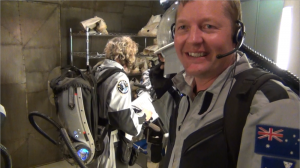"a passionate amateur astronomer with 24 years experience (as at 2014)
in running a range of education and public astronomy outreach activities." http://nightskyonline.info/?page_id=2
Paul Floyd in April 2012:
He had just finished a simulated walk on Mars at the Victorian Space Science Education Centre
(http://www.vssec.vic.edu.au). http://nightskyonline.info/?page_id=2
For those covering the 'Space Sciences' component of the Australian Curriculum: Science curriculum (or equivalent) this term, make sure you ask your students to look at the Moon Wednesday night as it occults Saturn.Essentially what they will see is Saturn (looking like a moderately bright pale yellow star) disappear behind the Moon then reappear on the other side of the Moon. How long this takes will depend on where you are in Australia. Observing this provides a nice and relatively rare demonstration of the 3D nature of space, and of the fact that the Moon is orbiting the Earth (causing the occultation).
I recommend that you visit Paul's website and check out the valuable resources available including The Australian Curriculum "Earth & Space Science" resources that he is developing and The Free Student astonomy newsletter for each term.Binoculars are recommending for observing the occultation due to the fact that the Moon is very close to being full, and therefore as Saturn draws closer to the Moon, the glare from the Moon will make it more difficult to see Saturn disappear and reappear.Event times and a chart for different locations in Eastern Australian for this occulation can be found here: http://nightskyonline.info/?page_id=11288Regards,Paul Floyd.
I love his scale model of the Sun, Earth & Moon System which would help "you to achieve part of one of the following elaborations from either the Year 3 or the Year 5 The Australian Curriculum, Science / Science Understanding / Earth and space science content areas.
- Year 3 Elaboration 4: Modelling the relative sizes and movement of the sun, Earth and moon (ACSSU048).
- Year 5 Elaboration 2: Modelling the relative sizes and movement of the sun, Earth and moon modelling the relative size of and distance between Earth, other planets in the solar system and the sun (ACSSU078)." http://nightskyonline.info/?p=2122



No comments:
Post a Comment